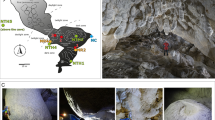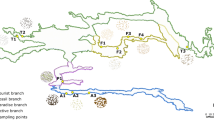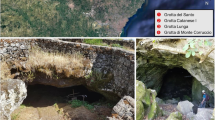Abstract
(Alpine) caves are, in general, windows into the Earth’s subsurface. Frequently occurring structures in caves such as moonmilk (secondary calcite deposits) offer the opportunity to study intraterrestrial microbial communities, adapted to oligotrophic and cold conditions. This is an important research field regarding the dimensions of subsurface systems and cold regions on Earth. On a methodological level, moonmilk deposits from 11 caves in the Austrian Alps were collected aseptically and investigated using a molecular (qPCR and DGGE sequencing-based) methodology in order to study the occurrence, abundance, and diversity of the prevailing native Archaea community. Furthermore, these Archaea were enriched in complex media and studied regarding their physiology, with a media selection targeting different physiological requirements, e.g. methanogenesis and ammonia oxidation. The investigation of the environmental samples showed that all moonmilk deposits were characterized by the presence of the same few habitat-specific archaeal species, showing high abundances and constituting about 50 % of the total microbial communities. The largest fraction of these Archaea was ammonia-oxidizing Thaumarchaeota, while another abundant group was very distantly related to extremophilic Euryarchaeota (Moonmilk Archaea). The archaeal community showed a depth- and oxygen-dependent stratification. Archaea were much more abundant (around 80 %), compared to bacteria, in the actively forming surface part of moonmilk deposits, decreasing to about 5 % down to the bedrock. Via extensive cultivation efforts, it was possible to enrich the enigmatic Moonmilk Archaea and also AOA significantly above the level of bacteria. The most expedient prerequisites for cultivating Moonmilk Archaea were a cold temperature, oligotrophic conditions, short incubation times, a moonmilk surface inoculum, the application of erythromycin, and anaerobic (microaerophilic) conditions. On a physiological level, it seems that methanogenesis is of marginal importance, while ammonia oxidation and a still undiscovered metabolic pathway are vital elements in the (archaeal) moonmilk biome.









Similar content being viewed by others
References
Castelle CJ, Wrighton KC, Thomas BC, Hug LA, Brown CT, Wilkins MJ, Frischkorn KR, Tringe SG, Singh A, Markillie LM, Taylor RC, Williams KH, Banfield JF (2015) Genomic expansion of domain Archaea highlights roles for organisms from new phyla in anaerobic carbon cycling. Curr Biol 25:690–701
Zuo G, Xu Z, Hao B (2015) Phylogeny and taxonomy of Archaea: a comparison of the whole-genome-based CVTree approach with 16S rRNA sequence analysis. Life 5:949–968
Petitjean C, Deschamps P, Lopez-Garcia P, Moreira D, Brochier-Armanet (2015) Extending the conserved phylogenetic core of Archaea disentangles the evolution of the third domain of life. Mol Biol Evol 32:1242–1254
Cavicchioli R (2011) Archaea—timeline of the third domain. Nature 9:51–61
Rinke C, Schwientek P, Sczyrba A, Ivanova NN, Anderson IJ, Cheng JF, Darling A, Malfatti S, Swan BK, Gies EA, Dodsworth JA, Hedlund BP, Tsiamis G, Sievert SM, Liu WT, Eisen JA, Hallam SJ, Kyrpides NC, Stepanauskas R, Rubin EM, Hugenholtz P, Woyke T (2013) Insights into the phylogeny and coding potential of microbial dark matter. Nature 499:431–437
Petitjean C, Deschamps P, Lopez-Garcia P, Moreira D (2014) Rooting the domain Archaea by phylogenetic analysis supports the foundation of the new kingdom Proteoarchaeota. Genome Biol Evol 7:191–204
Woese CR, Fox GE (1977) Phylogenetic structure of the prokaryotic domain: the primary kingdoms. Proc Natl Acad Sci U S A 74:5088–5090
Woese CR, Kandler O, Wheelis ML (1990) Towards a natural system of organisms: proposal for the domains Archaea, Bacteria, and Eucarya. Proc Natl Acad Sci U S A 87:4576–4579
Brochier-Armanet C, Boussau B, Gribaldo S, Forterre P (2008) Mesophilic crenarchaeota: proposal for a third archaeal phylum, the Thaumarchaeota. Nature 6:245–252
Epstein SS (2013) The phenomenon of microbial uncultivability. Curr Opin Microbiol 16:636–642
Alain K, Querellou J (2009) Cultivating the uncultured: limits, advances and future challenges. Extremophiles 13:583–594
Vartoukian SR, Palmer RM, Wade WG (2010) Strategies for culture of ‘unculturable’ bacteria. FEMS Microbiol Lett 309:1–7
Leadbetter JR (2003) Cultivation of recalcitrant microbes: cells are alive, well and revealing their secrets in the 21st century laboratory. Curr Opin Microbiol 6:274–281
Knittel K, Boetius A (2009) Anaerobic oxidation of methane: progress with an unknown process. Annu Rev Microbiol 63:311–334
Rooney DC, Hutchens E, Clipson N, Baldini J, McDermott F (2010) Microbial community diversity of moonmilk deposits at Ballynamintra cave, Co. Waterford, Ireland. Microb Ecol 60:753–761
Canaveras JC, Cuezva S, Sanchez-Moral S, Lario J, Laiz L, Gonzalez JM, Saiz-Jimenez C (2006) On the origin of fiber calcite crystals in moonmilk deposits. Naturwissenschaften 93:27–32
Portillo MC, Gonzalez JM (2011) Moonmilk deposits originate from specific bacterial communities in Altamira cave (Spain). Microb Ecol 61:182–189
Probst AJ, Moissl-Eichinger C (2015) “Altiarchaeales”: uncultivated Archaea from the subsurface. Life 5:1381–1395
Ramanan R, Kannan K, Sivanesan SD, Mudliar S, Kaur S, Tripathi AK, Chakrabarti T (2009) Bio-sequestration of carbon dioxide using carbonic anhydrase enzyme purified from Citrobacter freundii. World J Microbiol Biotechnol 25:981–987
Emerson JB, Thomas BC, Alvarez W, Banfield JF (2015) Metagenomic analysis of a high carbon dioxide subsurface microbial community populated by chemolithoautotrophs and bacteria and Archaea from candidate phyla. Environ Microbiol. doi:10.1111/1462-2920.12817
Dubey G, Kollah B, Ahirwar U, Tiwari S, Mohanty SR (2015) Significance of Archaea in terrestrial biogeochemical cycles and global climate change. Afr J Microbiol Res 9:201–208
Banks ED, Taylor NM, Gulley J, Lubbers BR, Giarrizo JG, Bullen HA, Hoehler TM, Barton HA (2010) Bacterial calcium carbonate precipitation in cave environments: a function of calcium homeostasis. Geomicrobiol J 27:444–454
Gonzalez JM, Portillo MC, Saiz-Jimenez C (2006) Metabolically active Crenarchaeota in Altamira cave. Naturwissenschaften 93:42–45
Snider JR, Goin C, Miller RV, Boston PJ, Northup DE (2009) Ultraviolet radiation sensitivity in cave bacteria: evidence of adaption to the subsurface? Int J Speleol 38:11–22
Reitschuler C, Lins P, Schwarzenauer T, Spötl C, Wagner AO, Illmer P (2015) New undescribed lineages of non-extremophilic Archaea form a constant and dominant element within alpine moonmilk microbiomes. Geomicrobiol J 32:890–902
Reitschuler C, Lins P, Wagner AO, Illmer P (2014) Cultivation of moonmilk-born non-extremophilic Thaum and Euryarchaeota in mixed culture. Anaerobe 29:73–79
Spötl C, Reimer PJ, Luetscher M (2014) Long-term mass balance of perennial firn and ice in an Alpine cave (Austria): constraints from radiocarbon-dated wood fragments. The Holocene 24:165–175
Yu Y, Lee C, Hwang S (2005) Group-specific primer and probe sets to detect methanogenic communities using quantitative real-time polymerase chain reaction. Biotechnol Bioeng 89:670–679
Reitschuler C, Lins P, Illmer P (2014) Primer evaluation and adaption for cost-efficient SYBR Green-based qPCR and its applicability for specific quantification of methanogens. World J Microbiol Biotechnol 30:293–304
Rooney-Varga JN, Anderson RT, Fraga JL, Ringelberg D, Lovley DR (1999) Microbial communities associated with anaerobic benzene degradation in a petroleum-contaminated aquifer. Appl Environ Microbiol 65:3056–3063
Schabereiter-Gurtner C, Maca S, Rölleke S, Nigl K, Lukas J, Hirschl A (2001) 16S rDNA-based identification of bacteria from conjunctival swabs by PCR and DGGE fingerprinting. IOVS 42:1164–1171
Pereyra LP, Hiibel SR, Prieto Riquelme MV, Reardon KF, Pruden A (2010) Detection and quantification of functional genes of cellulose-degrading, fermentative, and sulfate-reducing bacteria and methanogenic archaea. Appl Environ Microbiol 76:2192–2202
Martineau C, Whyte LG, Greer CW (2010) Stable isotope probing analysis of the diversity and activity of methanotrophic bacteria in soils from the Canadian High Arctic. Appl Environ Microbiol 76:5773–5784
Auguet JC, Nomokonova N, Camarero L, Casamayor EO (2011) Seasonal changes of freshwater ammonia-oxidizing archaeal assemblages and nitrogen species in oligotrophic alpine lakes. Appl Environ Microbiol 6:1937–1945
Harms G, Layton AC, Dionisi HM, Gregory IR, Garrett VM, Hawkins SA, Robinson KG, Sayler GS (2003) Real-time PCR quantification of nitrifying bacteria in a municipal wastewater treatment plant. Environ Sci Technol 37:343–351
Dedysh SN, Panikov NS, Tiedje JM (1998) Acidophilic methanotrophic communities from sphagnum peat bogs. Appl Environ Microbiol 62:922–929
Onstott TC, Moser DP, Pfiffner SM, Fredrickson JK, Brockman FJ, Phelps TJ, White DC, Peacock A, Balkwill D, Hoover R, Krumholz LR, Borscik M, Kieft TL, Wilson R (2003) Indigenous and contaminant microbes in ultradeep mines. 5:1168-1191
Könneke M, Bernhard AE, de la Torre JR, Walker CB, Waterbury JB, Stahl DA (2005) Isolation of an autotrophic ammonia-oxidizing marine archaeon. Nature 437:543–546
Weber KA, Achenbach LA, Coates JD (2006) Microorganisms pumping iron: anaerobic microbial iron oxidation and reduction. Nature 752:752–764
Berg IA, Kockelkorn D, Ramos-Vera WH, Say RF, Zarzycki J, Hügler M, Alber BE, Fucks G (2010) Autotrophic carbon fixation in Archaea. Nature 8:447–460
Khelaifia S, Drancourt M (2012) Susceptibility of Archaea to antimicrobial agents: applications to clinical microbiology. Clin Microbiol Infect 18:841–848
Lins P, Reitschuler C, Illmer P (2012) Development and evaluation of inocula combating high acetate concentrations during the start-up of an anaerobic digestion. Bioresour Technol 110:167–173
Wagner AO, Lins P, Illmer P (2012) A simple method for the enumeration of methanogens by most probable number counting. Biomass Bioenerg 45:311–314
Kandeler E, Gerber H (1988) Short-term assay of soil urease activity using colorimetric determination of ammonium. Biol Fertil Soils 6:68–72
Walker CB, de la Torre JR, Klotz MG, Urakawa H, Pinel N, ArpDJ B-AC, Chain PSG, Chan PP, Gollabgir A, Hemp J, Hügler M, Karr EA, Könneke M, Shin M, Lawton TJ, Lowe T, Martens-Habbena W, Sayavedra-Soto LA, Lang D, Sievert SM, Rosenzweig AC, Manning G, Stahl DA (2010) Nitrosopumilus maritimus genome reveals unique mechanisms for nitrification and autotrophy in globally distributed marine crenarchaea. PNAS 107:8818–8823
Pester M, Schleper C, Wagner M (2011) The Thaumarchaeota: an emerging view of their phylogeny and ecophysiology. Curr Opin Microbiol 14:300–306
Itoh T, Yoshikawa N, Takashina T (2007) Thermogymnomonas acidicola gen. nov., sp. nov., a novel thermoacidophilic, cell wall-less archaeon in the order Thermoplasmatales, isolated from a solfataric soil in Hakone, Japan. Int J Syst Evol Microbiol 57:2557–2561
Reysenbach AL, Liu Y, Banta AB, Beveridge TJ, Kirshtein JD, Schouten S, Tivey MK, von Damm KL, Voytek MA (2006) A ubiquitous thermoacidophilic archaeon from deep-sea hydrothermal vents. Nature 442:444–447
Hanson RS, Hanson TE (1996) Methanotrophic bacteria. Microbiol Rev 60:439–471
Ercolini D (2004) PCR-DGGE fingerprinting: novel strategies for detection of microbes in food. J Microbiol Methods 56:297–314
Portillo MC, Gonzalez JM (2008) Statistical differences between relative quantitative molecular fingerprints from microbial communities. Antonie Van Leeuwenhoek 94:157–163
Lin X, Kennedy D, Fredrickson J, Bjornstad B, Konopka A (2011) Vertical stratification of subsurface microbial community composition across geological formations at the Hanford Site. Environ Microbiol 14:414–425
Margesin R, Miteva V (2011) Diversity and ecology of psychrophilic microorganisms. Res Microbiol 162:346–361
Acknowledgments
We are grateful to the Tiroler Wissenschaftsfonds (TWF) for funding a significant part of this study and to A. Rettenbacher, R. Erlmoser and R. Pavuza for providing moonmilk samples.
Author information
Authors and Affiliations
Corresponding author
Rights and permissions
About this article
Cite this article
Reitschuler, C., Spötl, C., Hofmann, K. et al. Archaeal Distribution in Moonmilk Deposits from Alpine Caves and Their Ecophysiological Potential. Microb Ecol 71, 686–699 (2016). https://doi.org/10.1007/s00248-015-0727-z
Received:
Accepted:
Published:
Issue Date:
DOI: https://doi.org/10.1007/s00248-015-0727-z




